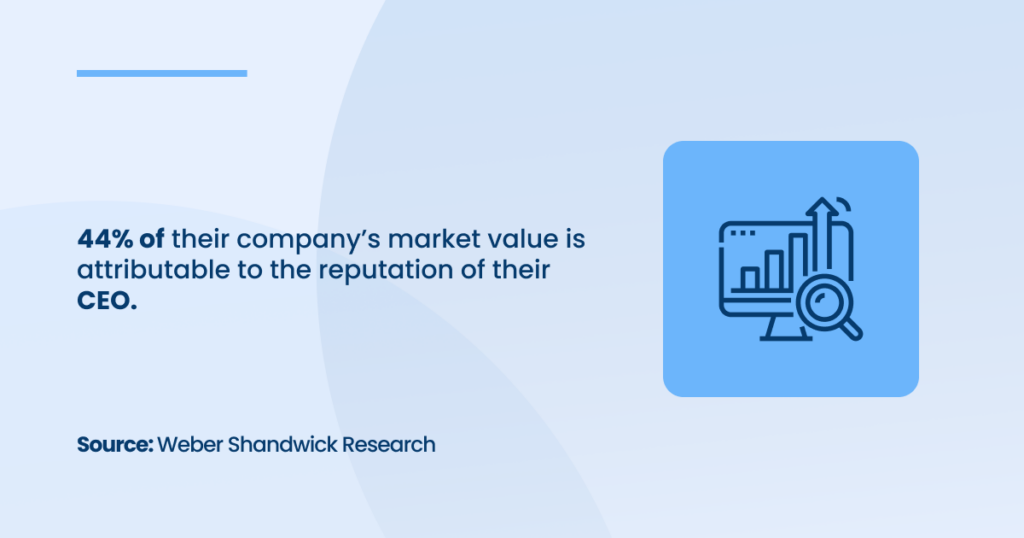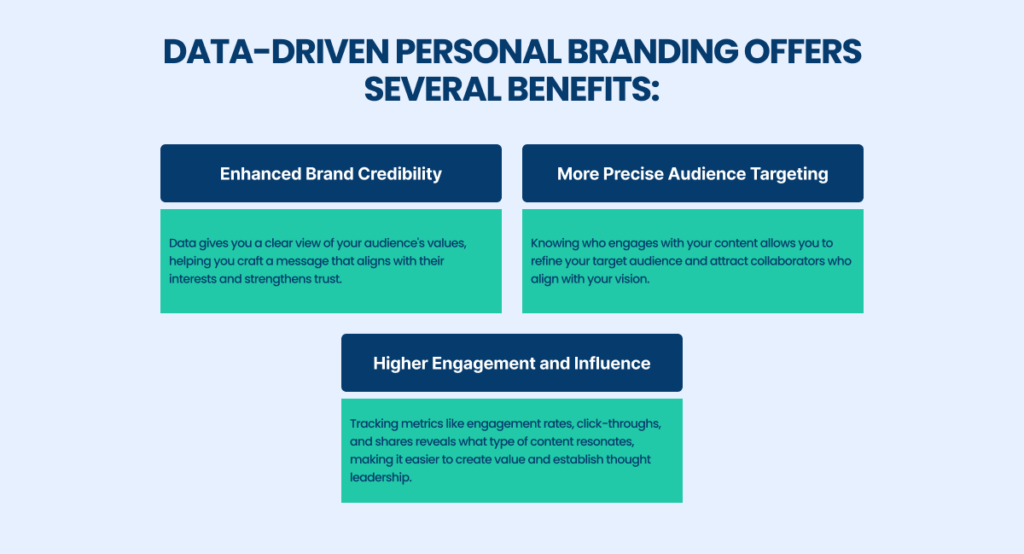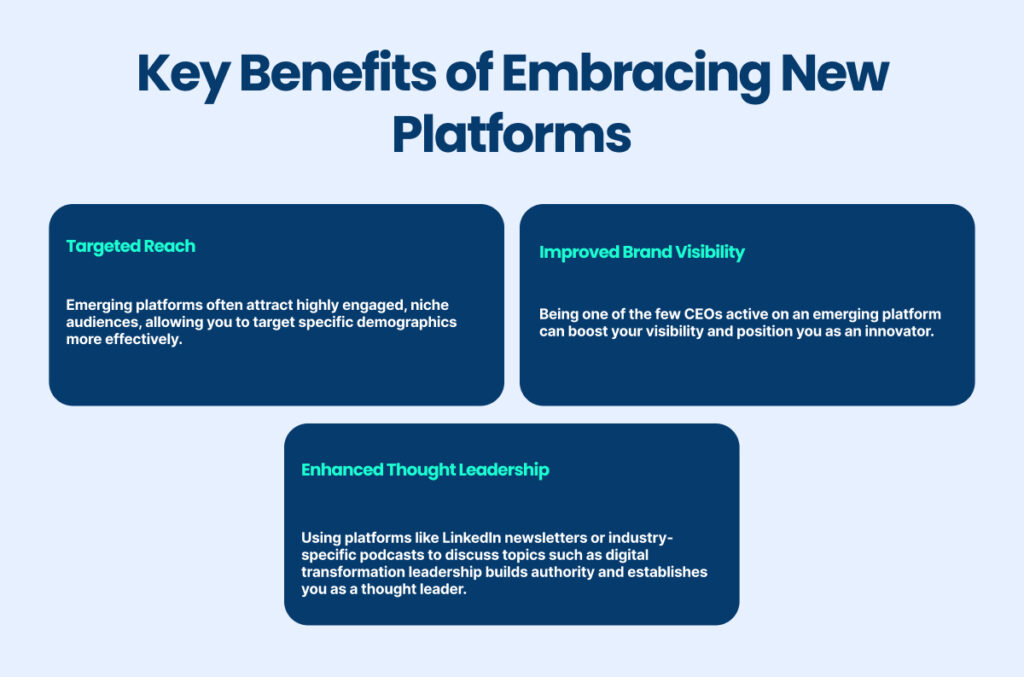Your personal brand isn’t just a logo or a tagline.
It’s your reputation, influence, and ability to connect with others.
We constantly ask ourselves: How can we truly rise above the noise in a world where everyone is building a brand?
What distinct strategies can we use to craft a personal brand that isn’t just memorable but truly unforgettable?

LinkedIn Study notes that 70% of hiring managers say that a strong personal brand is more important than a strong resume.
Creating a unique brand identity, highlighting your expertise, and clearly conveying your value proposition leave a lasting impression that draws in employers, clients, and collaborators.
Indeed, a professional Thought Leadership Agency will take this to the next level by refining your brand narrative and amplifying your voice across the right platforms.
Shortly, we’ll dive into personal branding’s unconventional strategies that will set you apart.
Navigating Authenticity: Building a Brand That’s True to You
In an era where authenticity has become essential, personal branding strategies that genuinely reflect who you are can set you apart in powerful ways.
Whether you’re a CEO or a business owner, creating an authentic personal brand isn’t just a matter of good marketing – it’s about establishing real, lasting connections with your audience.
Today’s business environment demands more than authority marketing and thought leadership.
The question isn’t just how to become a thought leader but how to become a trusted, relatable figure whose values align with your audience’s.
Showing Up as Your True Self: Why Authenticity Matters More Than Ever
As people’s expectations around transparency and connection grow, your audience isn’t just looking for a leader—they’re looking for someone they can trust.

Forbes shows that 86% of consumers say authenticity matters when deciding what brands they like and support. For CEOs, authenticity builds trust and paves the way for credibility.
For example, Elon Musk’s unfiltered communication style draws loyal followers and investors alike, creating a unique balance between transparency and a bold, often controversial personal brand.
While some may find it unconventional, his approach has made his brand unforgettable and distinct. He doesn’t shy away from who he is, and his audience knows what to expect: innovation, ambition, and a willingness to take risks.
So, how does authenticity translate into a successful personal branding strategy for you?
By choosing to show up in a way that feels real rather than calculated. This means your communication reflects your values and personality, which not only strengthens your brand reputation but fosters trust and loyalty.
Balancing Transparency and Professionalism in Your Personal Brand
Authenticity doesn’t mean oversharing; it’s about sharing the right things thoughtfully.
When crafting a personal brand, one of the trickiest aspects is striking a balance between being transparent and maintaining professionalism.
For instance, Microsoft’s CEO Satya Nadella demonstrates this balance.
While he openly discusses his motivations and values, particularly around empathy and inclusivity, he does so in a way that aligns with Microsoft’s values and mission.
His blend of transparency and professionalism not only humanizes him but also strengthens his brand reputation and that of Microsoft.
1. Know Your Story and Own It
The best way to engage audiences and build a genuine brand reputation is through storytelling.
Take time to understand your own journey—whether it’s the challenges that shaped your career, lessons from past failures, or your motivation to drive change. Share it in a way that’s both relatable and professional, bringing depth to your brand without losing credibility.
For example, Sara Blakely, the founder of Spanx, regularly shares stories about the early days of her business, including personal setbacks and lessons learned. Her openness has made her brand relatable to both entrepreneurs and consumers, fostering deep brand loyalty and trust.
Authenticity in storytelling is about being vulnerable without being unguarded. The key lies in choosing which aspects to highlight to underscore your values and expertise.
2. Transparency with Boundaries
Transparency does not mean exposing every aspect of your life to the public. Instead, it’s about being open in ways that align with your values and professional goals. Decide what areas you’re willing to share and which to keep private.
Setting boundaries will help you maintain professionalism while still being relatable and open with your audience.
For CEOs, this could mean sharing the motivation behind certain business decisions or challenges faced along the way, but without delving into overly personal details. Transparency with boundaries ensures that you appear both authentic and composed, giving you control over your narrative.
3. Create a Brand That Reflects Not Just What You Do But Why You Do It
Purpose is one of the strongest driving forces behind successful brands. By expressing your “why,” you give your audience a reason to connect with you beyond your expertise. This builds a sense of community and loyalty.
For instance, Patagonia’s former CEO, Yvon Chouinard, has always been outspoken about his passion for the environment, making sustainability a cornerstone of Patagonia’s mission. As a result, his personal brand reputation resonates with like-minded individuals and strengthens the company’s brand.
Communicating your purpose is a critical part of authority marketing. It shows that your brand is not only about profit but about making a difference.
When people know what drives you, they’re more likely to remember and connect with your brand. This level of thought leadership marketing allows you to showcase expertise and ethics, paving the way for a lasting impact in your industry.
Leveraging Data and Analytics: Using Insights to Shape Your Personal Brand
Data is the backbone of impactful personal branding strategies.
For CEOs and business owners, building a personal brand isn’t just about crafting a compelling story—it’s about knowing what resonates with your audience, adapting to trends, and reinforcing your brand credibility.
Source: Fortune Business Insights
By utilizing data and analytics, you can continually refine your personal brand based on what works, making it both relevant and memorable.
Why Data Matters in Personal Branding
Gone are the days when branding was based solely on gut feeling. Now, real-time data helps us understand the pulse of our audiences and adjust our approach accordingly.

When CEOs and leaders actively use data to shape their brands, they can cultivate a strategic and authentic strategy, aligning with audience expectations and digital transformation leadership goals.
Data-Driven Branding: Letting Insights Lead the Way
Making data an integral part of your branding strategy doesn’t have to be complex. Numerous tools and platforms provide insights that simplify decision-making and offer valuable analytics to elevate your brand reputation.
Let’s look at how these tools can guide you in refining your personal branding efforts.
1. LinkedIn Analytics: Measuring Professional Influence
LinkedIn is more than just a networking site; it’s a powerful platform for CEOs to build brand credibility and authority.
LinkedIn Analytics offers actionable insights into how your posts, articles, and profile are performing:
- Audience Demographics: LinkedIn Analytics helps you see who’s viewing your profile, breaking down viewers by industry, location, job title, and more. This allows you to understand your audience better and tailor content that speaks to them directly.
- Post Performance: Find out which posts generate the most engagement and impressions. This insight can guide you in developing similar content that resonates with your audience, boosting your thought leadership.
- Followers’ Activity: By understanding your followers’ behavior and engagement patterns, you can post at optimal times and increase the reach of your thought leadership content.
Example: If you notice that a particular LinkedIn post about digital transformation leadership received higher-than-average engagement, consider expanding on this topic in future posts or articles. This focus will not only boost visibility but also establish you as a reliable authority in that area.
2. Google Alerts: Tracking Brand Mentions and Trends
Google Alerts is a simple yet effective tool for staying on top of your brand mentions and relevant industry topics.
You can receive real-time updates whenever these terms appear online by setting up alerts for your name, business, or industry keywords.
- Brand Monitoring: Google Alerts lets you track when and where you’re mentioned across the internet. This is a great way to understand your brand’s reach and how your authority marketing efforts resonate with your audience.
- Industry Trends: Setting alerts for industry keywords helps you stay informed about market trends. For example, an alert for “thought leadership examples” can help you identify fresh ideas and discover successful strategies others employ.
- Competitor Insights: You can also monitor competitors to see what they’re doing well and identify opportunities where your brand can stand out.
Example: By tracking alerts for “thought leadership in AI,” you may come across articles discussing new trends or innovations in the field. This insight can inform your own content, allowing you to share relevant perspectives with your audience and establish yourself as an informed thought leader.
Elevate Your Brand with Purpose-Driven Leadership
Purpose-driven leadership has become a cornerstone of successful personal branding strategies.
For business owners and CEOs, aligning personal values with company goals creates an authentic narrative that strengthens brand reputation and resonates with audiences. It’s more than just having a mission—it’s about connecting with people through shared values, which drives loyalty and trust.
Why Purpose-Driven Leadership Matters
Purpose-driven brands aren’t only seen as credible; they also attract more engaged employees and devoted customers.
Key Benefits of Purpose-Driven Leadership:
- Enhanced Brand Credibility: A brand built on values is easier for people to trust. Statistics reveal that 62% of consumers want companies to stand up for the issues they care about (Edelman Trust Barometer), underscoring the importance of purpose-driven brands.
- Stronger Team Engagement: Employees are more likely to stay engaged and motivated when they understand and share the company’s purpose. Gallup data shows that purpose-driven organizations enjoy 10% higher employee retention rates.
- Higher Customer Loyalty: Customers who believe in a brand’s values are more likely to remain loyal. Studies indicate that 64% of consumers worldwide will buy or boycott a brand solely because of its position on a social or political issue.
Purpose at the Core: Aligning Your Mission with Your Brand
Creating a brand mission that genuinely reflects your values isn’t a one-time task. It’s about consistently showing up as a leader who champions that mission in everything they do.
When purpose is at the core, every brand interaction feels intentional, creating a story that draws in employees, customers, and partners alike.
Steps to Align Your Brand Mission with Your Personal Purpose:
- Identify Core Values: Consider what principles define you as a leader and find ways to integrate them into your brand’s mission. For instance, if sustainability is central to your values, let it be a visible part of your brand mission.
- Define Purpose-Driven Goals: Translate your values into business goals. For example, if community support is part of your brand, commit to donating a percentage of profits or supporting local initiatives.
- Incorporate Purpose into Brand Messaging: Consistently communicate this mission to your audience through your content. Ensure that every post, statement, or campaign reinforces this purpose, which builds brand credibility over time.
- Show Purpose in Action: Actions speak louder than words. As a CEO, lead by example and show your commitment to the mission through concrete actions—whether it’s volunteering time, endorsing purpose-led partnerships, or speaking on relevant causes.
Harnessing Emerging Platforms: Standing Out in New Digital Spaces
With the digital landscape constantly evolving, CEOs have more channels than ever to communicate their message.
Lesser-known platforms such as podcasts, video blogs, and LinkedIn newsletters offer fresh opportunities to connect with niche audiences. Adopting new platforms demonstrates adaptability and keeps your brand visible across diverse, engaged audiences.
Why Diversifying Platforms is Key for CEOs
While traditional social media platforms are effective, they can also be saturated. Engaging with emerging channels not only differentiates your brand but also showcases your adaptability, which is an essential trait for thought leaders.

Instead of limiting your brand to mainstream social media, explore alternative platforms to reach a broader yet targeted audience. Here are some platforms that can help you tell your story in ways that feel fresh and engaging:
Podcasts: Your Voice, Your Brand
Podcasts allow CEOs to dive deep into topics that matter to them, sharing insights in a way that feels personal and relatable.
Source: Number of users of podcasts in the United States from 2020 to 2029, Statista
Studies indicate that 55% of Americans have listened to podcasts, making it a viable medium for thought leadership marketing.
- How to Use: Share stories of overcoming challenges, discuss industry trends, and provide practical advice for entrepreneurs. Consistent podcast episodes can solidify your expertise and boost brand credibility.
- Example: A CEO focused on digital transformation might host a podcast series on “Innovation in Action,” where they discuss how technology reshapes their industry.
LinkedIn Newsletters: Direct, Engaging, and Insightful
LinkedIn’s newsletter feature is a powerful tool for CEOs who want to connect professionally and build authority within their network.
Source: Annual revenue generated by LinkedIn from fiscal year 2017 to 2024, Statista
LinkedIn newsletters allow regular communication directly to followers’ inboxes, making it a more personal way to share expertise.
- How to Use: Use newsletters to share insights, case studies, and industry updates. Topics like “What is Thought Leadership” or “How to Become a Thought Leader” could position you as an authority on thought leadership marketing.
- Example: Publish a monthly newsletter titled “Transforming Leadership in the Digital Age” to discuss trends in leadership, emerging technology, and best practices.
Video Blogs: Show, Don’t Just Tell
Video blogs, or “vlogs,” bring a dynamic element to personal branding by allowing CEOs to visually connect with their audience.
Video has proven to be a highly engaging format, with 92% of marketers noting its importance in their strategies.
Source: Businesses who see video as an important part of their marketing strategy, Wyzovl
- How to Use: Vlogs can cover a variety of content—from “Day in the Life” segments to Q&A sessions on relevant industry topics. This format shows authenticity and builds trust.
- Example: If you’re known for thought leadership in sustainability, post short, insightful videos discussing eco-friendly practices and innovations in your field.
Medium: Publish In-Depth Content for Broader Reach
Medium is a platform for long-form content and thought leadership, ideal for CEOs looking to publish in-depth articles on trends, opinions, or insights.
Medium’s wide readership allows your expertise to reach beyond your immediate network.
- How to Use: Share well-researched articles on topics like authority marketing or digital transformation leadership. Medium’s platform can boost your articles’ reach with its own network of engaged readers.
- Example: Publish an article on “Brand Reputation: Why Purpose-Driven Leaders Win the Loyalty Game” to gain traction among readers interested in leadership and brand credibility.
Crafting a High-Impact Personal Brand Strategy with AI and Tech Tools
In an age where technology reshapes how we connect and communicate, leveraging AI and digital tools can transform personal branding from a time-intensive task into a streamlined, high-impact strategy.
For business owners and CEOs, incorporating AI not only optimizes branding efforts but also ensures more precise, data-driven approaches to reach and engage audiences effectively.
Why AI and Technology Are Game-Changers in Personal Branding
AI and tech tools can simplify and elevate your brand-building process in ways that were once unimaginable.
They can personalize audience interactions, help you track and analyze trends, and provide insights that keep your branding consistent and relevant.
This blend of automation and intelligence means you’re not only reaching your audience more efficiently but also enhancing brand credibility through carefully crafted, data-informed content.
Automate and Amplify: Tools to Streamline Your Branding
Let’s explore some practical AI-driven tools and strategies to streamline and amplify your branding efforts.
AI-Powered Content Creation and Refinement
Generating impactful content is at the heart of personal branding, but crafting, editing, and optimizing each piece can take considerable time.
AI tools like Jasper, Copy.ai, and Grammarly assist in generating polished, high-quality content that aligns with your brand voice.
How AI content tools enhance branding:
- Consistency and Quality: Tools like Jasper can generate initial drafts based on prompts, which you can then refine, saving time while ensuring that your brand reputation remains professional and engaging.
- Improved Readability: Grammarly’s AI-based suggestions refine the content structure, tone, and clarity, making your communication easier to digest and align with audience expectations.
By reducing your time on the basics, these tools allow you to focus on crafting thought-provoking ideas, increasing your impact as a thought leader.
Smart Scheduling with AI
Consistency is essential for a successful personal brand, but keeping up with multiple platforms can be overwhelming.
AI-driven scheduling tools like Buffer, Hootsuite, and Sprout Social allow you to plan and automate posts across various platforms, ensuring regular and timely updates.
Benefits of AI scheduling tools:
- Optimized Posting Times: These tools analyze past engagement data to recommend the best times to post, maximizing reach and visibility.
- Cross-Platform Management: Hootsuite and Buffer integrate with platforms such as LinkedIn, Twitter, and Facebook, making it easy to manage a unified presence without logging in and out of multiple sites.
- Content Calendar Visualization: You can visualize your content calendar and schedule posts months in advance, ensuring a cohesive branding strategy.
Pro Tip: By integrating AI scheduling with LinkedIn content marketing, you can build authority and reach targeted audiences by delivering relevant content when they’re most active, helping solidify your standing in authority marketing.
Sentiment Analysis for Brand Reputation Management
Understanding audience sentiment is vital in authority marketing and shaping your brand reputation.
Sentiment analysis tools like Brandwatch, Talkwalker, and MonkeyLearn provide insights into how people perceive your brand and identify the emotional tone behind mentions.
How sentiment analysis can elevate your brand:
- Real-Time Feedback: Sentiment analysis tools monitor brand mentions across platforms, allowing you to address negative feedback promptly and reinforce positive engagement.
- Audience Insights: By analyzing trends, these tools help you understand which topics resonate with your audience, enabling you to tailor your messaging to reinforce a positive reputation.
- Brand Reputation Management: Using AI-driven sentiment analysis, you can pivot your branding strategy based on audience perceptions, refining your image to be seen as a more trusted and engaging thought leader.
Example: A CEO could monitor sentiment around specific topics, like digital transformation leadership, to gauge how thought leadership examples are received and adjust messaging accordingly.
Personal Branding Strategies That Go Beyond the Ordinary
| Strategy | Key Points | Example Applications |
| Building Authenticity | Develop a true brand identity reflecting your core values; foster trust and loyalty. | CEOs like Elon Musk gain trust by communicating authentically, balancing transparency with professionalism. |
| Using Data & Analytics | Leverage insights to shape brand strategy and understand audience preferences. | Tools like LinkedIn Analytics for audience insights and Google Alerts for brand monitoring streamline data use. |
| Purpose-Driven Leadership | Align personal values with brand mission to engage customers, employees, and partners. | Patagonia’s focus on sustainability reflects its founder’s environmental values, strengthening brand loyalty. |
| Exploring Emerging Platforms | Use new digital channels (e.g., podcasts, LinkedIn newsletters) to connect with niche audiences in a fresh, engaging way. | CEOs utilize podcasts to share deep insights, creating an engaging personal connection with their audience. |
| AI and Technology Tools | Incorporate AI to automate branding tasks, create data-driven content, and maintain consistent engagement. | AI tools like Jasper for content creation and Hootsuite for scheduling allow leaders to focus on impactful activities. |
You already know that a distinctive personal brand can be the defining factor for success.
Building a brand that is not only recognizable but unforgettable requires a blend of authenticity, purpose, and strategic innovation.
[A] Growth Agency will constantly explore new ways to grow your brand. We specialize in turning entrepreneurial dreams into reality with effective, tailored growth strategies.
Excellence is our standard. We cultivate a team of ‘A players’ – top-tier talents who bring passion and expertise to every challenge.
Remember, we go beyond standard practices by employing cutting-edge techniques and tools to elevate your brand’s reach and impact.

